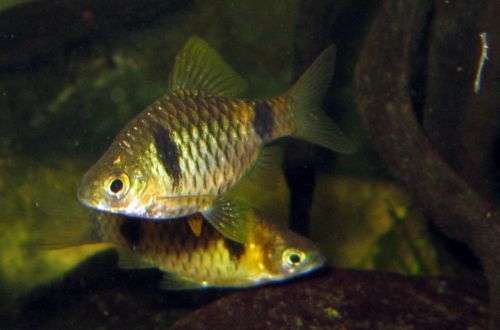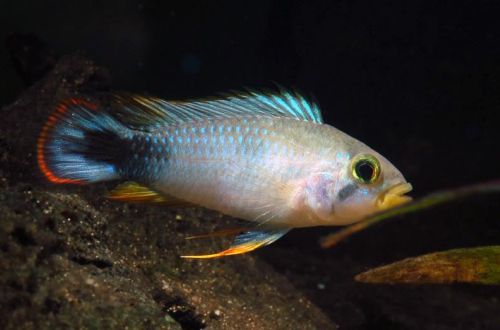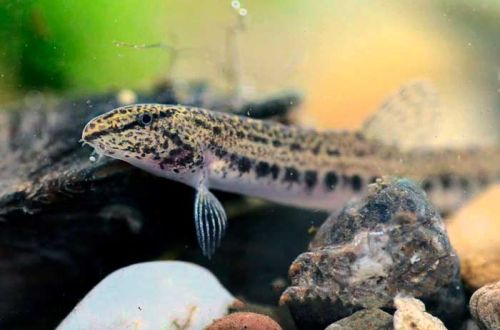
Cuming’s Barbus
The Cuming barb, scientific name Pethia cumingii, belongs to the Cyprinidae family. Peaceful friendly fish, will be a great addition to the community of species similar in temperament. It is not whimsical enough and practically does not require the cost of its maintenance, therefore it can be recommended to aquarists with a small or initial level of experience.

Contents
Habitat
Endemic to the island of Sri Lanka, lives mainly in two river systems with a moderate current and a sand and gravel substrate. The red-finned form is found in the Kelani River, and the yellow-ribbed variant is found in the Kalu River.
Nowadays, the brightly colored fish are becoming rarer in the wild and it is likely that active harvesting for the aquarium trade has greatly altered the population structure. The deforestation of the island and the pollution of water resources due to human activities also have a negative impact.
Description
The sizes of adults rarely exceed 5 cm, while males are noticeably smaller than females, but more colorful. There are two main color forms – with a red and yellow tinge of a predominantly silvery body. The first is less common, therefore it is valued more. A characteristic feature of the coloration are two dark oblong spots, one located behind the gill cover, the other closer to the base of the tail.
Food
They are not whimsical about food at all, they will accept all types of dry, frozen and live food. The main condition is that the food must be of high quality (do not use cheap feed), and also contain plant components. A varied diet will allow the fish to show brighter colors. Feed 2-3 times a day in the amount eaten by fish in 5 minutes, uneaten residues should be removed.
Maintenance and care, arrangement of the aquarium
A flock of Cuming Barbs will feel great in a tank of 60 liters or more. The decor doesn’t really matter, however, some elements can make the décor look more natural, such as using a dark substrate along with some driftwood and creating areas of dense vegetation. Floating plants will also come in handy.
The water parameters have a slightly acidic pH value and a low content of dissolved calcium and magnesium salts (dGH value). For more information about pH and dGH parameters, as well as ways to change them, see the “Hydrochemical composition of water” section.
The minimum set of equipment consists of a filtration system, lighting, aerator and heater. The filter in this case performs two functions at once – it not only purifies the water, but also creates an internal current (but not strong), which your fish will appreciate.
Maintenance of the aquarium is reduced to a weekly replacement of part of the water with fresh water with the same parameters in the amount of 15–20% of the tank volume. Cleaning the soil from organic waste as needed.
Behavior and Compatibility
An exceptionally peaceful gregarious species, which means keeping at least 6-10 individuals in a group. This will not only make it less shy, but also contribute to the development of bright colors in the color. The latter is especially characteristic of males, which, in the presence of potential rivals, will fight for the attention of females precisely due to body color.
The Cuming barb is compatible with most fish species similar in temperament and size, and should not be kept with large and/or aggressive fish.
Breeding / breeding
The existence of two sub-species (red and yellow) implies the possibility of producing offspring within only one color form to avoid hybridization – this is an ideal option that almost no one follows in the hobby aquarium, so constant mixing has led to a change in the main color to silver.
Breeding at home is quite simple, the fish are able to spawn in a common aquarium throughout the year, but due to the lack of parental instincts and the tendency to eat their own caviar, the survival of fry in these conditions will be at an extremely low level.
The chances will be higher if juveniles are caught and deposited in a timely manner, for example, in a three-liter jar, or spawning is carried out in a separate tank. Read more about spawning stimulation and reproduction of spawning species in the Breeding of aquarium fish section.
Fish diseases
The main reason for all diseases of aquarium fish is the inconsistency of the conditions of keeping with the needs of a particular species, or a significant deterioration in the quality of water, nutrition, etc. Fish do not get sick just like that, deterioration in health is almost always caused by external factors. Only a small number of selective species not found in the wild have hereditary diseases, but the Cuminga Barbus is not one of them.
If there are problems, first check the parameters of the water, the quality of the food, and only then take the medicine. Read more about symptoms and treatments in the Aquarium Fish Diseases section.





